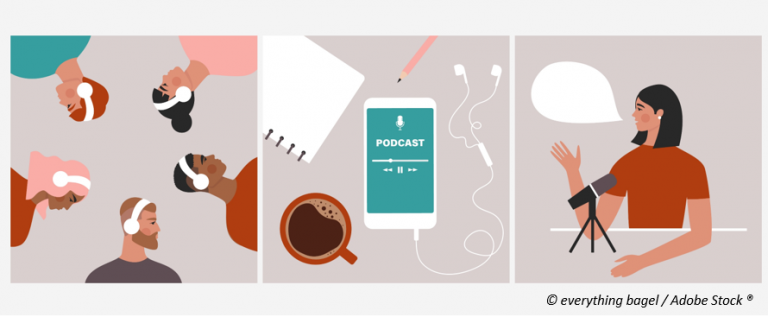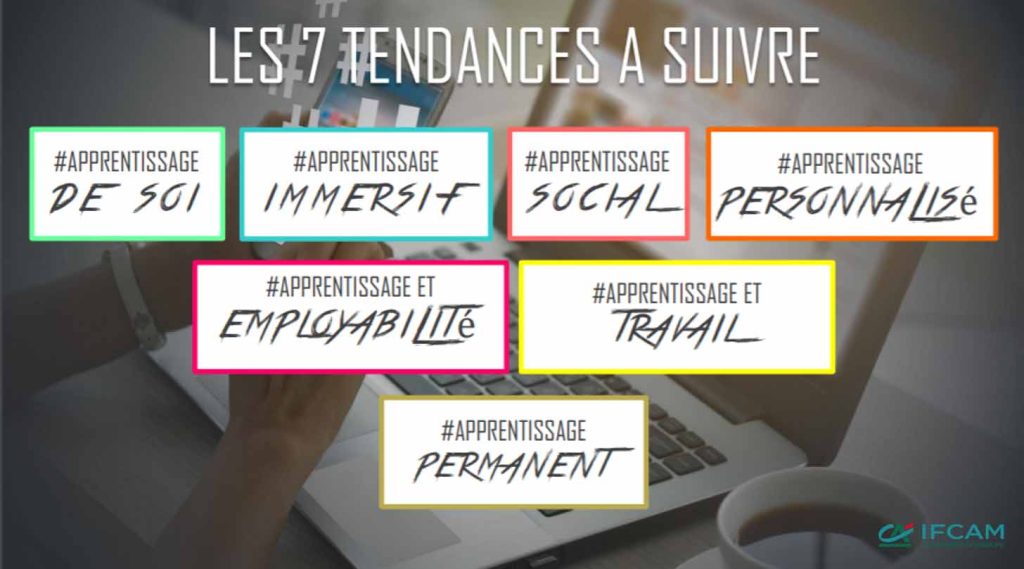Training trends 2022/2023
Since 2019, we have shared with you the training trends that we believe in. We follow 7 of them that we re-question every year. After learningsocial which was a big hit last year, and which has not lost its lustre, we choose to focus on lifelong learning as the top trend for 2022/23.
Lifelong learning: why this choice?
This trend ticks all the boxes! At a time when the pace of change is accelerating, distance learning is exploding, and teleworking is taking hold, there is a mix between work and training, a hybridization between places, temporality, and tools.
Learning is taken as a whole, understood as a process, and not just as an event, which combines time and place, where social connections, whether in the field or in virtual worlds, are not interrupted. All learning is to be valued: formal and informal, alone and with others, synchronous or asynchronous, via microlearning or long courses, with or without qualifications.
In short, we learn throughout life in many different ways.
The learner commits …
The corollary of this state of continuous learning is learner engagement! This word is at the heart of all debates, and of our definition of the learner experience.
First of all, it’s obvious that to be committed you need to be motivated… we invite you to re-read the article published on our blog: “Motivation, pleasure, value: be (self)determined” in which the different sources of motivation are described.
Faced with this individual commitment, which is always contextual, we have identified in our monitoring some interesting ideas (not necessarily new) that can be deployed to support employees in their learning efforts, in training schemes and beyond, on a daily basis.
1-self-assessment or rather positioning test
The elements of language evolve but the aim is the same, to combat the illusion of mastery and to set realistic and stimulating learning objectives. Upstream, downstream, during training in the form of anchoring activities… evaluation is everywhere, boosted by AI which promises predictive analysis. But one does not always evaluate oneself alone, the gaze of others is essential; feedback is therefore on everyone’s lips, and even a little more, as many training courses are already being offered and an experiment coupled with AI is being prepared at IFCAM.
Access to the results of research in cognitive sciences – which are also in the air at the moment – makes it possible to re-emphasise the importance of evaluation both for learning, making mistakes, anchoring, etc.
Diagnostic, formative or summative assessment is combined with AI for the development of adaptive pathways to maintain learner engagement over time.
2-Systematic situation analysis
“I spend my time doing what I don’t know how to do, in order to learn how to do it”: Pablo Picasso. Situation analysis reminds us that when you train you are also going to change practices.
Whether face-to-face or distance learning, everyone is encouraged to train at one’s own pace, alone or with others. New technologies help us to offer enriched environments to be ever closer to the field and to real situations. Digital twins connected to the production environment reinforce this trend and open up new possibilities for training (Badet & al., 2021).
Before the advent of the Metaverse and all its virtual worlds, virtual reality progressed without opposing the virtual to the real; the presence and emotions are real. Virtual reality allows us to experience situations that are ever closer to the work context, in which we can train and learn from our mistakes.
From simulation to job creation, learning is built throughout a process that is now broadened at AFEST thanks to the reflexivity of these situations.
3- the nudge: a little push for an immediate effect
The concept of nudge or ‘little push’ is based on the mobilisation of psychosocial factors influencing behaviour, highlighting that choices, far from being rational, are linked to a multitude of emotional and social parameters. (…) “. Nudge is based on the existence of cognitive biases and relies on : “ignorance, inertia, acrasia (lack of willpower), mimicry (peer effect), overvaluation of the cost of losing what one has compared to the gain from change (endowment effect), collective emulation.” (Cambon, 2016, p. 44).
Nudges are used to facilitate decision-making and action by guiding behaviour. From an ethical perspective, it is advisable to adopt an information based and transparent approach on the use of nudges, in order to give people the choice to avoid them if they wish.
Nudges are therefore a complement to the usual tools for informing or convincing people to take action and change their behaviour by :
– removing small obstacles
– pushing the right information at the right time
– providing a link, connivance.
4-Coaching is not an option
Autonomy has its limits: the number of deserted platforms or communities that do not survive is plentiful. There is a strong demand for support, particularly since the health crisis, but we can see that this demand persists regardless of the methods used: human or virtual coaching (AI/LA), a strong demand for a return to face-to-face training, peer-to-peer learning, and always the key role of the trainer/facilitator.
As training is transformed into a course, human support takes on its full meaning. Recalled by the legislator in the context of ODL*, it is the corollary of autonomy in training. It can take the form of tutoring, mentoring, etc.
We are also seeing a shift from coaching to facilitation in connection with collective intelligence methods, which are becoming more widespread with, for example, collaborative approaches to CSR issues.
5- A popular format: the podcast
The French are fans of podcasts and their use in companies is spreading. This was all it took for the training industry to seize on it: a short format, which forces people to concentrate their attention, which can be listened to anywhere, at any time … making it possible to enrich the hybridization of courses and resources, with a limited ecological impact. The voice reassures and gives a feeling of proximity like no other.
6- Scrollytelling, when narrative and web ergonomics complement each other
This term comes from a contraction of “storytelling” and “scroll”, the action of scrolling “up and down”. A fluidity that makes the narrative immersive and engaging. Thanks to parallax effects (the action of scrolling), the different multimedia elements arrive at different speeds, bringing a certain depth. Inspired by the journalistic style and the game world, the content is qualitative.
7-Recognition of effort or result?
Science teaches us that it is more effective to value learning rather than the result itself (Thill, 1999): so let us not hesitate to multiply the formulas: badges, labelling, peer recommendations, feedback, pressbooks, publication of signed articles, mentoring and tutoring. Of course, certification and diplomas still have a bright future ahead of them, but they are no longer an end in themselves.
The importance of feedback in training is recalled, even at a distance. A key element in formative evaluation, particularly in relation to the right to make mistakes, it is becoming a training theme. It no longer concerns only the trainer, but also the manager or peers.
In short, curiosity is no longer a bad habit and “learning to learn” is one of the key skills of the 21st century.
The Organisation is learning…
In a mindset of sharing experiences, of transmission, with a continuous approach in the work, through the work, in a formal or informal way, where the team link (hierarchical or project) is essential, there is a new gap between individual training and collective training plan.
How can we move from the company that trains to the company that learns
New actors and/or cumulative roles
Acculturation, learning and training complement each other and new professions are taking off: coaches, tutors, mentors, facilitators, incubators, etc. Sometimes, it is the same person who takes on several roles, requiring a change of posture and a good grasp of the shifting perimeter that this entails.
The training of trainers becomes the training of the woman or man-orchestra. Day-to-day learning in a work situation between peers is not new but is beginning to be recognised and valued.
New spaces: (teleworking, skills development platform, virtual worlds, nature)
After multimodal, multi-local is the new challenge for training. Training rooms, skill-building platforms, third places, home offices and public transport coexist with natural spaces that regenerate, inspire and promote learning (Kuo & Jordan, 2019).
Not to mention the virtual worlds that promise to connect to the real world, and transport us to any of these places at the click of a button, including imaginary places that by definition do not exist.
Behind the simmering demand for a return to the classroom, particularly among our work-study students who are calling for the return of teachers in the flesh (feedback from our work-study branch DIFCAM), lies a demand for reconnection. It is up to us to invent new environments that will succeed in this challenge without necessarily returning to training rooms alone.
Training becomes media
The subject of training marketing is often discussed, but less so that of training as a medium. However, just like brands, training is becoming a medium and attracting its audience with content adapted to professional or personal consumption habits, or even merging with them. Access to knowledge must be easy, integrated into everyday channels such as YouTube or Teams, or my favourite podcasting platform. The question then arises of the right balance between formal learning that meets pedagogical objectives with the intention of transforming practices and real-time access to volatile knowledge/information.
Sobriety: educational and digital
There is a paradox! Faced with the increased demand for choice, personalisation and adaptation, the natural temptation is to offer micro-content that can be arranged ad infinitum, or enriched 3.0, to multiply the formats, to offer some immersive …. The problem is that cognitive sciences and the environment are saying stop, or rather are inviting us to be more frugal when dealing with the learner. Beyond the cognitive overload (Fontaine et al, 2020) and energy expenditure, let’s go back to basics:
– Dare to be simple;
– Aim for efficiency by starting with the needs of learners thanks to UX approaches (observations, surveys, design thinking, empathy maps, etc.) with more test and learn for pragmatic implementation and the development of a design centred on the learner experience (Learner eXperience Design, LXD);
– Draw on the sciences to objectify choices;
– Think techno as much as nature: Green is at the heart of our activities, why not at the heart of training? Whether in terms of design, content or partners;
– Encourage curation, so as not to repeat what already exists.
A learning culture
The learning organisation draws its strength from a fertile ground where time is a priority, the right to make mistakes becomes a duty, the practice of monitoring and prototyping is encouraged… Is the lack of time a false excuse? In a large cosmetics group, in the Asian sector, the head of learning explains that China trains twice as many of its employees as France and it is China that drives the group’s innovation ….
And if the “secret” was the learning team (hierarchical or not): Mutual aid, collective problem solving, sharing of good practices, so many approaches that call on numerous collective intelligence methods (CODEV, world café, appreciative inquiry, design of the future, learning loop, etc.). The team is the agile link, which can take initiatives as close to the field as possible, with a degree of autonomy and responsibility. Learning is integrated into the workflow.
This responsibility to learn in order to progress is now shared: the learner is committed, the manager creates the working conditions to encourage opportunities to learn, the new support professions are alongside the trainers… In the end, we are talking about the Organisation as a whole, beyond the traditional HR support. This is organised and is called the Learning Organisation (Peter Senge, 2006).
Finally, it should be noted that according to the LinkedIn 2021 study, the subject of learning is on the table of the CODIRs to a greater extent, rising from an active support of 30% to 70% from March 2020 to March 2021.
Because ethics is everyone’s business
Finally, we would like to share with you a surprise: the subject of ethics. It affects many areas and paradoxically, given the stakes, it is not dealt with very much by speakers, publishers and providers …. However, whether we are talking about soft skills, coaching of all kinds, data processing to make AI work, evaluation, and even nudges, the subject of manipulation can, and must, be raised. We have a role to play in guaranteeing the frameworks. At IFCAM, we are very sensitive to this and it is part of our selection criteria for trends or experiments.
In summary, after the pandemic, a profound change seems to be taking place: everything is becoming a matter of (re)connection: linking the growth of the company to the growth and well-being of its employees, giving meaning back to the collective, linking the inside of the company to the outside: to its ecosystem, to nature, in line with CSR approaches.
Nathalie Paquet-Vérot, Head of Learner Experience Communication
Crossed views with : Dorothée Cavignaux-Bros, Doctor of Education and Training Sciences and Learner Experience Training Engineer, Faty Drider, Educational Engineer, Michel-François Kmiec, Head of LAB Prospective Training, Isabelle Holié, Head of Purchasing and Educational Sourcing and Head of Coaching for Managers and Staff, Evelyne Truong, Training Engineer and the many authors of our blog.
Sources :
https://www.agence-gsp.com/pantone-devoile-la-couleur-de-lannee-2022
Salon Learning Technologies
Badets, A., Blandin, B., Havard, V. & Baudry, D. (2021). Conception de situations instrumentées: étude de cas d’une situation d’apprentissage des concepts du Lean Manufacturing.
Cambon, L. (2016). Le nudge en prévention… troisième voie ou sortie de route ?. Santé Publique, 28, 43-48.
Fontaine, G., Cossette, S., Maheu-Cadotte, M. A., Mailhot, T., Lavoie, P., Gagnon, M. P., … & Côté, J. (2020). Traduction, adaptation et évaluation psychométrique préliminaire d’une mesure d’engagement et d’une mesure de charge cognitive en contexte d’apprentissage numérique. Pédagogie Médicale, 20(2), 79-90. Kuo, M., & Jordan, C. (2019). The natural world as a resource for learning and development: From schoolyards to wilderness. Frontiers in Psychology, 10, 1763. Senge, P. M. (2006). The fifth discipline: The art and practice of the learning organization. Broadway Business.
Thill, E. (1999). Compétence et effort: structuration, effets et valorisation de l’image de compétence. FeniXX.
LinkedIn-Learning-Workplace-Learning-Report-2021-FR.pdf
*Décret n° 2018-1341 du 28 décembre 2018 relatif aux actions de formation et aux modalités de conventionnement des actions de développement des compétences






